Catalogue number 128008
Martin P5M-2 Marlin
In this photograph, we can see the powerful search light pod under the tip of the starboard wing for use in ASW. Note the attachment for stores under the wings, just outboard of the engines.
Verso: “…. Now in quantity production at the Martin plant in Baltimore, Md., this new anti-submarine seaplane will soon be joining squadrons of the Atlantic and Pacific fleets. Powerful search radar located in its white nose, coupled with associated electronic equipment and a full store of rockets, depth charges, or torpedoes, make this new seaplane a potent threat to even snorkelling enemy submarines. Powerful Wright 3400 hp. Engines give the P5M-2 long range and speed with which to fulfill its mission of submarine detection and kill.”
Credit: Martin, Information Services
24.2cm x 19.5cm Gelatin silver print
|
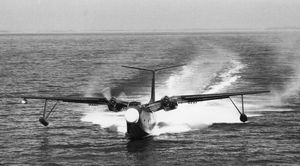 |
Catalogue number 128121
Martin P5M
The French Navy had the use of ten Marlins from the U.S. Navy in the late 59s. Note the search light under the starboard wing, the magnetic anomaly detector on the tail fin and the radome just aft of the cockpit.
16.8cm x 11.6cm Photograph
|
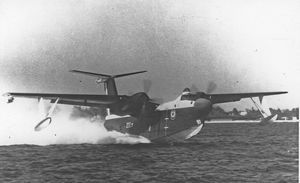 |
Catalogue number 99006
Martin P5M Marlin, French Aeronavale
In 1964, the French Navy Marlins were returned to the U.S. Navy.
Credit: E.C.P.-Armées
18cm x 12.8cm Gelatin silver print
|
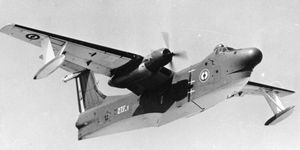 |
Catalogue number 28001
Martin PBM-5 Mariner
With its gull wing and four-bladed propellers, this Mariner is being brought aboard a U.S. Navy seaplane tender,probably U.S.S. Pine Island, the aircraft weighed over 25 tons so a hefty crane was needed. We can see the randome of the AN/APS-15 air surface radar just behind the cockpit.
24cm x 19.5cm Gelatin silver print
|
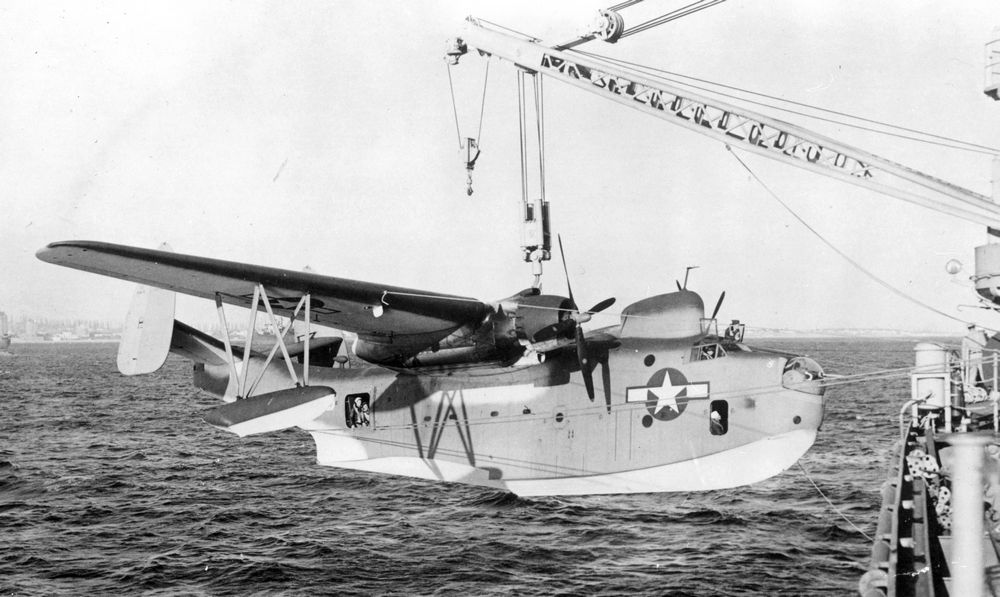 |
Catalogue number 37102
Martin PBM-5, detail
The Mariner is on the apron resting on stub wheels and a neat tail wheel, 1951.
Credit: U.S. Naval Air Station, San Diego
24cm x 19.4cm Gelatin silver print
|
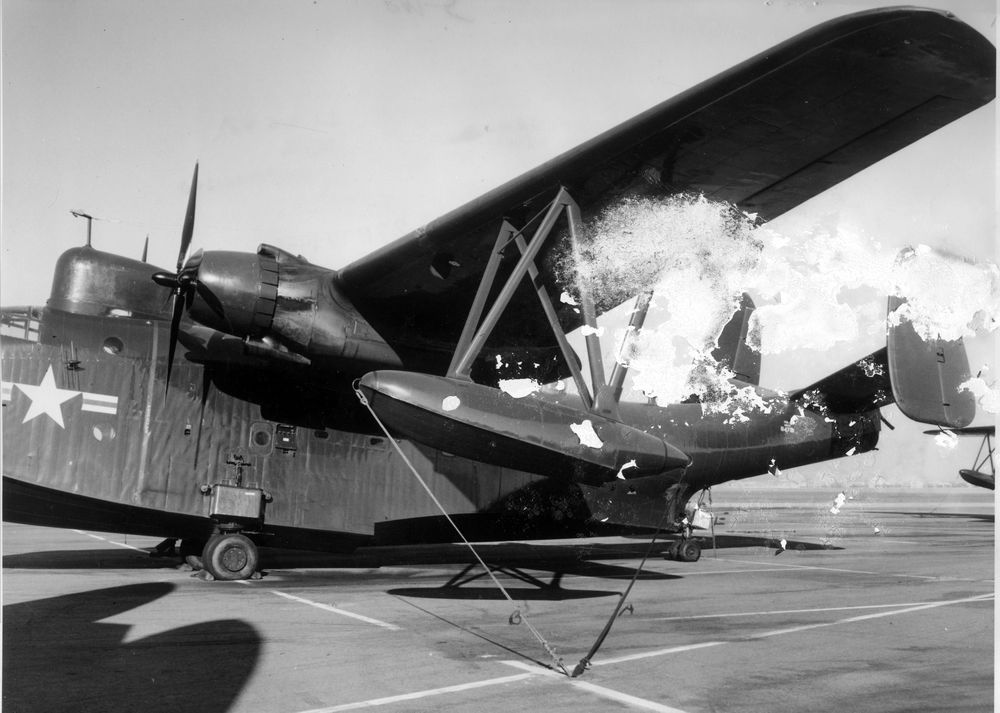 |
Catalogue number 128007
Martin PBM-5 Mariner
The later Mariner PBM-5A was equipped with a retractable undercarriage giving it a full amphibious capacity. A post-war improvement was the introduction of the improved APS-31 ASR in the teardrop radome.
Credit: The Glenn Martin Company
24.5cm x 18.5cm Gelatin silver print
|
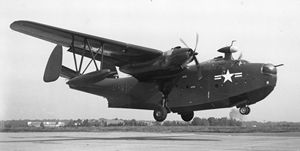 |
Catalogue number 125083
Martin P6M SeaMaster, 1955
The Martin P6M SeaMaster was the result of a post-war battle for funding and maintaining a strategic role between the U.S. Air Force and the U.S. Navy. Aircraft were expected to deliver nuclear weapons in the event of another war and the U.S. Navy sent out tenders for a heavy, 14 tonne bomb load, seaplane nuclear bomber with a reconnaissance and minelaying capacity. The four turbojet engines sat in pairs over the wings but testing revealed scorching of the rear fuselage/engine pods as can be seen in this 1955 photograph taken at the Martin Aircraft Works, Baltimore. This is the prototype XP6M-1, it crashed in December 1955. Note the wing tip floats/fuel pods.
Verso: “Martin XP6M-1 Seamaster 3.2.55
Credit: Martin Aircraft Information Services, Baltimore 3, Maryland
23.6cm x 17.7cm Gelatin silver print
|
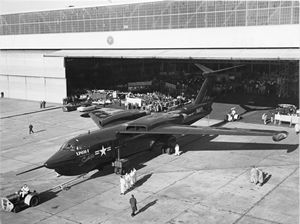 |
Catalogue number 125084
Martin P6M SeaMaster, 1955
The potential of the SeaMaster was great, it had the vast expanses of the oceans as a runway compared to conventional land-based nuclear bomber. However, budget cuts and an excessive development period meant the Navy’s role in nuclear strategy was taken over by the Polaris ballistic missile launched from submarines. We can see how close the inboard jet nozzles are to the fuselage. The wings has a distinct anhedral form with stable floatation obtained from the wing tip fuel pods. Note the rear twin machine gun turret.
Verso: “Martin XP6M-1 Seamaster 3.2.55
Credit: Martin Aircraft Information Services, Baltimore 3, Maryland
23.8cm x 17.5cm Gelatin silver print
|
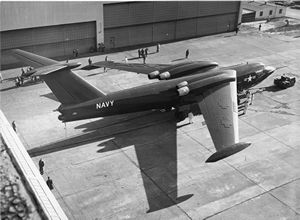 |
Catalogue number 128005
Martin P6M SeaMaster, 1955
An important part of the SeaMaster programme was to produce a suitable system for moving the seaplane out of/into the sea. Here we can see the independent motorized buggies latched onto the hull. Note the inverted lip around nose to help keep spray off the cockpit.
Credit: Martin Aircraft, Baltimore 3, Maryland
23.9cm x 19.4cm Gelatin silver print
|
 |
Catalogue number 129007
Martin P6M SeaMaster, January 1955
This photograph was taken prior to the first flight of XP6M-1 in July 1955. The aircraft is out on the apron and we can see the huge jet engine pods over the wings, the anhedral wing shape and the wing tip floats/ fuel pods. Their almost horizontal alignment plus wing flexing during take-off and landing meant that they had a strong tendency to bit into the sea with the consequent effect on aircraft stability.
Verso: "5 January 1955"
Credit: Martin Aircraft, Baltimore 3, Maryland
23.9cm x 19.4cm Gelatin silver print
|
 |
----------OOOOOOOOOO----------
Catalogue number 128013
Bringing a Caudron J floatplane on board the Foudre, 1914
The Foudre was a torpedo boat/submarine carrier that was modified to become a floatplane carrier. A derrick is being used to bring a Caudron J onto the deck. Note the man standing on the motor, the wheels in the floats as well as the gantry for moving the torpedo boats/submarines and the keen photographer.
Verso: “The floatplane Caudron” in French and in black ink
Credit: S.A.F.A.R.A.
9cm x 13.9cm Gelatin silver print
|
 |
Ships converted to early aircraft carriers
Catalogue number 20038
The first Ark Royal aircraft carrier
In 1914, a collier was converted to a seaplane carrier and named H.M.S. Ark Royal. The ship was later renamed H.M.S. Pegasus to free up the name Ark Royal for a new carrier. This carrier lacked the speed for any fleet action, the solution, as we will see below, was to convert the very much fast cross-channel and small passenger ships
Verso: “H.M.S. “Ark. Royal.” Aircraft carrier also in the lower regions carries oil fuel to supply the ships at sea.” in black ink
Credit: Abrahams
12.3cm x 6.7cm Gelatin silver print
|
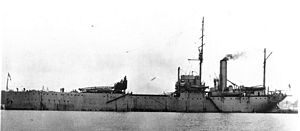 |
Catalogue number 117063
Handling a floatplane on H.M.S. Ark Royal
The limited space on H.M.S. Ark Royal made it difficult to manoeuver a floatplane between the hold and the hanger as well as lifting it in and out of the sea. The Short Admiralty type 166 shown here had folding wings to assist storage in the hangar/hold
Verso: “English aircraft hoisted on board a ship Bay of Salonica 1916” in French and in black ink
20.2cm x 15.1 cm Gelatin silver print
|
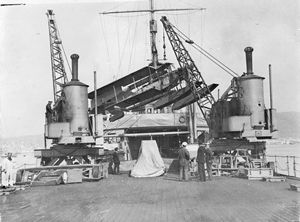 |
Catalogue number 66028
Launching a floatplane
A Short 166 being lowered from H.M.S. Ark Royal into the sea, 1915. Note the men on deck holding lines to steady the tail and floats.
Credit: Imperial War Museum (IWM Non-Commercial Licence)
20.4cm x 15.3cm Gelatin silver print
|
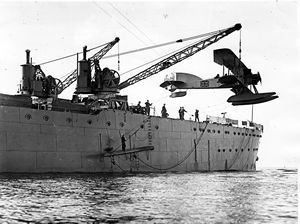 |
Catalogue number 108038
Develpments in launching and recovering aircraft
In 1940, H.M.S. Pegasus (ex-Ark Royal) was converted for trials with a fighter catapult. The catapult was fixed to the raised structure on deck forward of the cranes. We can also see the Hein mat platform that was used in trials to recover a floatplane whilst underway (see catalogue n° 118125 below).
Recto: “H.M.S. Pegasus”
13.4cm x 8.5cm Gelatin silver print
|
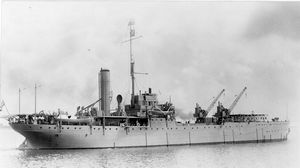 |
Catalogue number 118125
The Hein mat
This photograph gives a good view of a Hein mat being deployed over the stern of the French cruiser Foch in the mid-1930s. The floatplane would come up from the stern and ride over and onto the floating mat, all whilst the ship was underway. The floatplane would then be hoisted on board by a crane.
14.4cm x 9.5cm Gelatin silver print
|
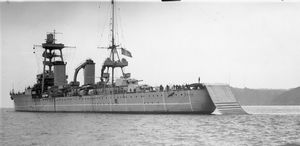 |
Catalogue number 131019
Trials with Hein mat: coming onto the mat
A Gourdou-Leseurre floatplane is moving onto the deployed Hein mat as Foch steams slow ahead. Note the rope going back from the hull, almost at sea level and to the front of the mat. This line kept the forward lip of the mat down as it was pulled through the sea.
14.3cm x 9.6cm Gelatin silver print
|
 |
Catalogue number 131020
Floatplane up onto the mat
The mat is trailing behind Foch and the Gourdou-Leseurre has run up onto the mat. As well as the French Navy, other navies made trials using the Hein mat including Sweden, the Royal Navy and Italy.
15.9cm x 11.3cm Gelatin silver print
|
 |
Catalogue number 79027
The cross-channel ferry Engadine converted to an aircraft carrier
We can see a floatplane at the entrance to the hangar right aft. The ship is camouflaged.
Credit: Abrahams
13.2 cm x 7.5cm Gelatin silver print
|
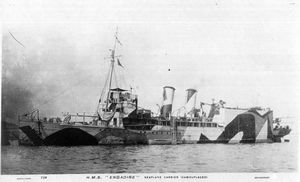 |
Catalogue number 35275
The second H.M.S. Pegasus
H.M.S. Pegasus was a fast passenger ship converted in 1917 to an aircraft carrier with a large hangar and cranes working over the stern. This H.M.S. Pegasus was sold in 1931 so enabling the name to be transferred to the ex-Ark Royal in 1934.
Recto: “Pegasus” in gold paint
Credit: Real Photographs Co.
14cm x 9 cm Gelatin silver print
|
 |
Catalogue number 24008
An early flight deck fitted to H.M.S. Pegasus
A forward flight deck was built up to launch wheeled aircraft brought up to the flight deck by lift from the forward hangar. In this photograph, the ship has acquired dazzle camouflage.
Recto: “British Aeroplane ship Part of the Grand Fleet
Credit: Denson
12.9cm x 8cm Gelatin silver print
|
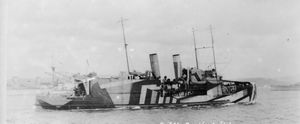 |
| Japanese aircraft flown by the French Aeronavale |
Catalogue number 65058
Japanese bomber examined by the ATAIU
The Asia Technical Air Intelligence Unit (ATAIU) was part of an intelligence network setup to recover and evaluate Japanese aircraft. Technical merits were examined and test flights were made to reveal weak points in the aircraft's performance that could be used by the Allies. Here a crashed Japanese bomber from the Pearl Harbour attack in under study.
16.2cm x 17.3cm Gelatin silver print
|
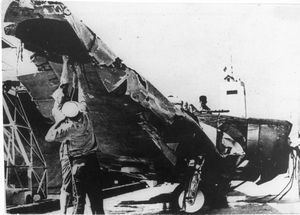 |
Catalogue number 105028
French-flown Nakajima A6M2-N Rufe, 1946
The Rufe was based on the Zero fighter but the addition of floats greatly diminished its performance. This aircraft was recovered in Surabaya and flown by the R.A.F. to Singapore and then on to a base in Malaya for evaluation by the ATAIU. It was then handed over to the French Aeronavale who operated this aircraft in what was then Indochina but it crashed during a mission in 1946. Cat Lai, now in Vietnam, had a base of the French Aeronavale from 1931 to 1953.
Verso: “Nakajima.A6M2.N- Code "Rufe" 1946. Esc. 8S. Cat. Laï” in black ink
Credit: Photo Gamec. Collection Thomé
17cm x 12cm Gelatin silver print
|
 |
Catalogue number 105029
French-flown Nakajima A6M2-N Rufe, 1946
The French airforce base of Bien Hoa was particularly active from 1946 during the Indochina war and this photograph shows the French Rufe being launched. This was the aircraft in which Enseigne de vaisseau Raymond Hostalier was killed during a trial flight at low altitude, the aircraft going into the river near Ba-sang. Note the insignia "ATAIU on the tail.
Verso: "Bien Hoa beginning 1946. Nakajima A6M2-N Code "Rufe" (Zero floatplane version)" in pencil and in French
17.2cm x 12cm Gelatin silver print
|
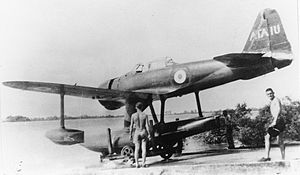 |
Catalogue number 105030
French-flown Nakajima A6M2-N Rufe, 1946
The 8S squadron of the French aeronavale flew the Japanese aircraft Nakajima A6M2-N Rufe and the Aïchi Jake. This photograph shows a French aeronavale Aichi E13A long-range reconnaissance floatplane flying over the Donai meanders. France operated several Aichi Jake's during the Indochina war.
Verso: "Aïchi-Kokuki Esc 8S Cat Lai 1946 Flying over Donai" in black ink
Credit: Photo Gamec Collection Thomé
17.2cm x 12cm Gelatin silver print
|
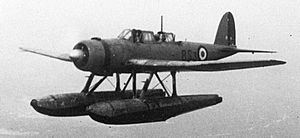 |